In itself, the presence of a well does not mean that a country house or cottage will be adequately supplied with water. Even in the best scenario, when there is enough water pressure to raise the pillar to the surface, an autonomous system in the house will not function. In order for water to flow from all taps and household appliances to work, the minimum supply should be 2.5 atmospheres, which it copes with borehole pump.
Before you go shopping, you need to make the correct calculation of the operation of the borehole pump. It is short-sighted to buy a pump that cannot cope with the load, as well as to choose a "fancy" model, the power of which is enough for 3 such wells as yours. In both cases, the purchase will be unjustified, and there and there you will waste your money. We will consider how to carry out the calculation and how to use it as productively as possible in a dacha or cottage.
Preliminary parameters
Before deciding to buy submersible pump, it is necessary to measure the well itself and understand which unit will be the most the best option. So we measure:
- hole depth;
- dynamic liquid level to determine the opening debit;
- statistical water level - the distance from the surface to the liquid mirror;
- borehole pipe diameter.
To obtain water for domestic purposes, the best option would be a submersible pump - centrifugal or vibration, depending on which principle of operation is provided for in the device. For deep wells it is not recommended to use a vibrating device without a casing pipe, since constant vibration will lead to shedding of sand and soil, gradual filling of the well and clogging of the pump.
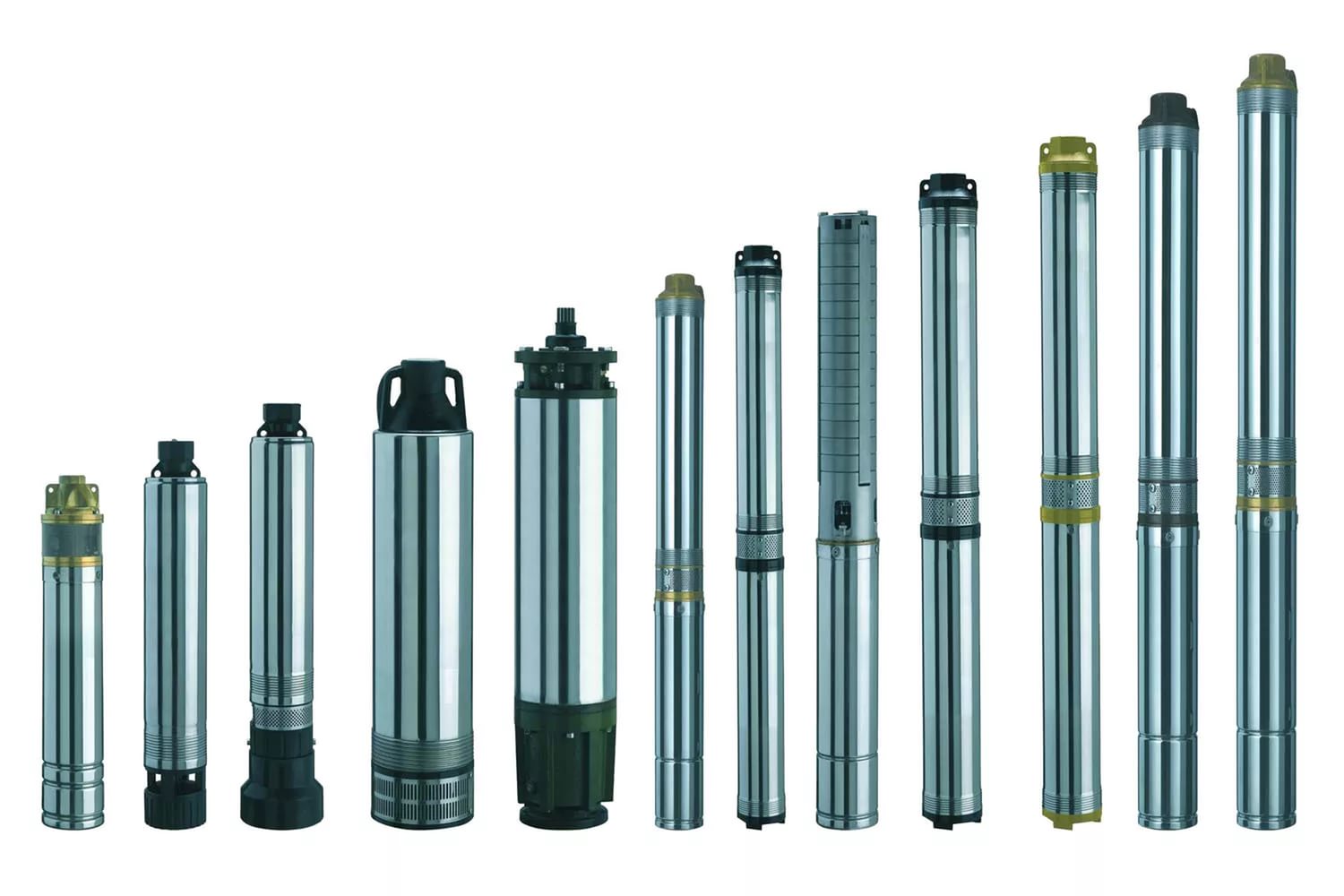
Required water pressure
Let's start by calculating the required flow, which is the sum of all consumers available on the site. In addition, you need to analyze how much a person uses the liquid, and calculate maximum flow water.

We need to find out what pressure will be when working with submersible pump. To determine this indicator, it is better to carry out a couple of simple calculations, which will include the dynamic opening depth at a certain device performance, as well as the head loss and the height where consumers are installed. These parameters are individual in nature, and therefore we can only talk about optimal performance: To maintain a normal pressure of 2.5 bar, the fixture must provide 70 m of fluid head.
Consumption rate
So, first you need to choose the type of equipment, which is submersible or self-priming. And in order to correctly determine what is right for you, you should study all the characteristics and parameters well. If there is already a ready-made object on which you want to install equipment, then there must be a project.
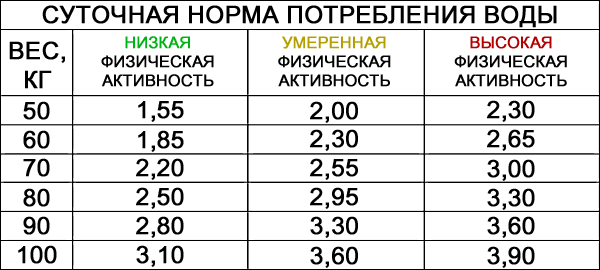
Let's get back to household needs. It is generally accepted that on average, the norm of water per person is 200 ml. If these 200 ml were used up in a couple of hours, then a family of 4 people can consume about 0.5 m 3 / h. If water is also used for additional needs, then consumption will increase to 1.5 m 3 / h.
The formula for calculating a pump for a well
Let's take a look at simple example. We have a family of 4 people. Let's say they live in own house outside the city, and for their site we will take equipment with a load of 1.7 m3 / h. We need to find out if there will be enough pressure for the water supply device to the second floor of the house in the bathroom. To calculate, you need to know:
- the standard value, let's denote it P and we will assume that it is 2.5-3 atm;
- the difference between the strongest draw point and the dynamic level, which we will call ∆H;
- value that shows the size of hydraulic losses - ∑∆P
We derive the general formula by which the head is calculated: H = ∆H + 10.2xP + ∑∆P and we obtain the size of the minimum head H.
After all measurements have been taken, it is necessary to start selecting equipment. It is worth choosing a unit that, in terms of its characteristics, will be the closest to what the calculation formula showed us. In addition, be sure to compare the parameters of the well itself and the pump.
If you are using a submersible pump, then its diameter must be smaller than the hole.
Electrical characteristics
The electrical output is important aspect when calculating the power cable, as well as special electrical devices for guard. There is one small nuance that distinguishes this characteristic from all the others. To determine the load of electricity, it is not necessary to carry out any additional calculations. It is enough to study the technical characteristics of the equipment, which are usually indicated in the passport. Also, in order for the work to be carried out normally and with high level safety, it is necessary to match the cable and the power of the electricity that the unit consumes.
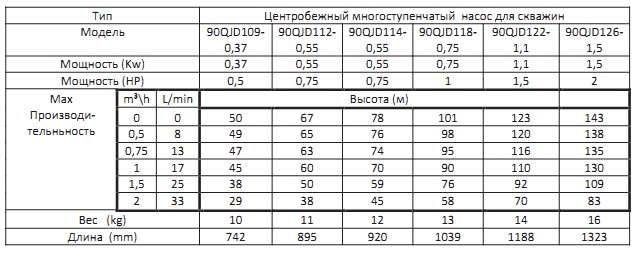
When calculating the power of a borehole pump for water supply to a site, a number of nuances must be taken into account, and therefore, if there is no certainty in the correctness of the calculations, it is better to contact specialists.
What criteria should be followed when choosing a pump
For those who are not satisfied with the operation of old equipment, a couple of tips on how to choose a well pump that will be more productive will be useful. For example, choosing a centrifugal pump, you can avoid that the well will be covered with sand. In order to obtain high quality water, it is better to install the device no less than 1 meter from the filter. When water consumption, it is necessary to take into account not only average figures, but also peak indicators. In addition, you need to ensure that there is enough water for technical needs. A good pressure will be provided by a pump in which the power reserve will be approximately 20%.
The decrease in pressure is facilitated by the appearance of silt in the well or the use of filters. Self-calculations of a pump for a well in terms of head power may not be accurate, and therefore it is better to take the help of professionals in this matter.
Also important: the diameter of the device must be at least 1 cm smaller than the well in which it is used. It will do easier installation and also increase the operating time of the pump.
In addition, in addition to the main characteristics, when choosing a device, you should pay attention to its immersion depth and the pressure that the device creates. The equipment can be different and in diameter. There are those in which the indicators are small - 100 mm. They appearance may resemble a kind of elongated cylinder, which can be lowered to the bottom of our well hole without any problems. There are also devices for the well, the diameter of which is larger, but the immersion depth is less. But they can be noted the effective use of the engine.
Before installing the device, you must take a hose or pipe desired length and size in order to connect it to the inlet of the pumping equipment. It is selected depending on what will be the depth of immersion. The presence of a check valve is also important, so if it is not included in the standard package, then it is better to install it yourself. If this part is missing, then the fluid will return back to the well.
It is better to entrust the installation of a device for pumping water to professionals, because installation work pretty complex. In addition, you need to know that the equipment itself will not be able to perform its direct function so simply. To do this, additional devices are needed, such as:
- membrane tank;
- Electronic control unit;
- A gauge that shows pressure;
- pressure gauge;
- Coupling;
- Clamps.
After you have all the details, you can proceed with the installation of the unit. Before starting it, you need to check the pressure in the tank and the correctness of all connections. When all installation work is done, the device can begin to function and supply water from the well. This unit makes it possible to provide water supply to any suburban area so it is in high demand in the market. In addition, its volume of performance allows it to be used on an industrial scale.
The basis of any water supply system is right choice pump and calculation of pump power for water wells, since the quality of water, the reliability and efficiency of the system as a whole, as well as the comfort of use will depend on these factors in the future. Below will be described how to calculate the power of the pump according to the rules and methods that are used in practice by specialists in this field.
To calculate the power of a pump for water wells, you can use the calculator for calculating the power of a pump for water wells.
Algorithm for calculating the pump power for water wells.
1. The first step is to choose the type of equipment - self-priming or submersible. In order to determine what you need, you should familiarize yourself in detail with the main characteristics and parameters of the pumps. For example, self-priming pump equipment delivers water to the earth's surface from a depth of about 7 m without the use of an ejector and up to 9 m with a built-in ejector.
There are also special pumps with a remote ejector that can deliver water from depths of about 40 m.
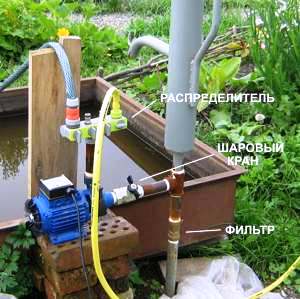
Tip: there is no need to use this kind of equipment, since at the time of water intake, this type of pump pumps part of the liquid back into the well, while wasting excess energy, which is very uneconomical.
2. Advantages of suction pumps:
Can be used as a small pumping station. You just need to connect the equipment to the well and you can already pump water;
There is constant access for repair and diagnostics of equipment, since the pump itself is located on top. He also works in more comfortable conditions compared to submerged equipment.
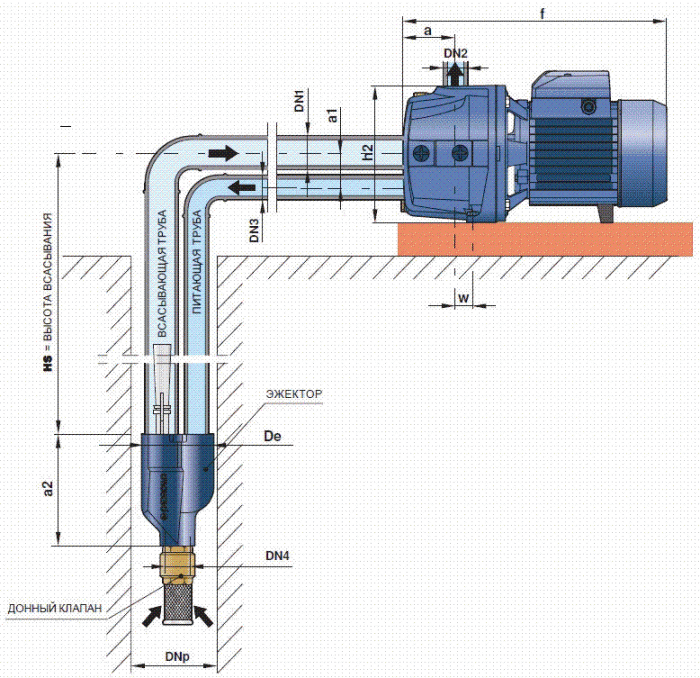
3. To determine what type of pump is needed in your case, you need to find out the flow rate of the well itself. Based on this, the pump performance should be 10-30% less. Otherwise water well will constantly silt up.
4. To meet specific needs, you need to determine the minimum capacity of the equipment. Yes, for big industrial facilities the calculation depends on the number of employees and production capacity. Of such kind industrial pumps usually equip frequency converter or automatic system with soft start.
Calculation of the performance of pumping equipment for water wells.
For a specific object, the overall performance is necessarily provided for in the project. For example, for a private household, the amount of water consumption is determined based on regulatory data. It is accepted that on average 200 ml of water is needed per person per day. This is taking into account that water consumption will occur in the morning and in the evening.
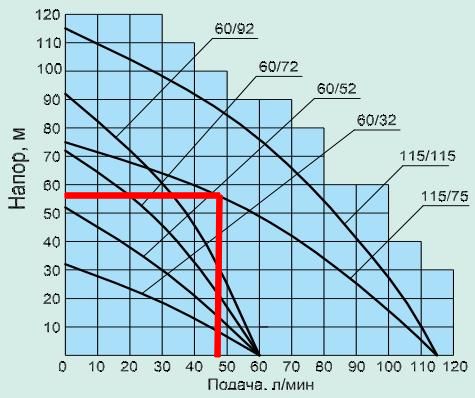
If we take into account that these normative 200 ml will be consumed in 2 hours, then for a family of 4 people, the average water consumption will be approximately 0.5 m3 / h. In addition, if water is still used for additional needs, for example, watering beds, then this will require 1.5 m3 / h. Thus, the total productivity of the equipment must be at least 2 m 3 / h.
An example of calculating the pump power for water wells.
This example will show how calculate the pump for the well. Let's say there are 4 people in a family. They live outside the city, in a private house with a garden and a kitchen garden. For calculation, we take a pump with a capacity of 1.7 m3 / h.
It is necessary to determine whether there will be enough pressure from this pump to deliver water to the bathroom, which is located on the second floor of the house.
Tip: do not forget to take into account the flow rate of the well and compare the pump power with it.
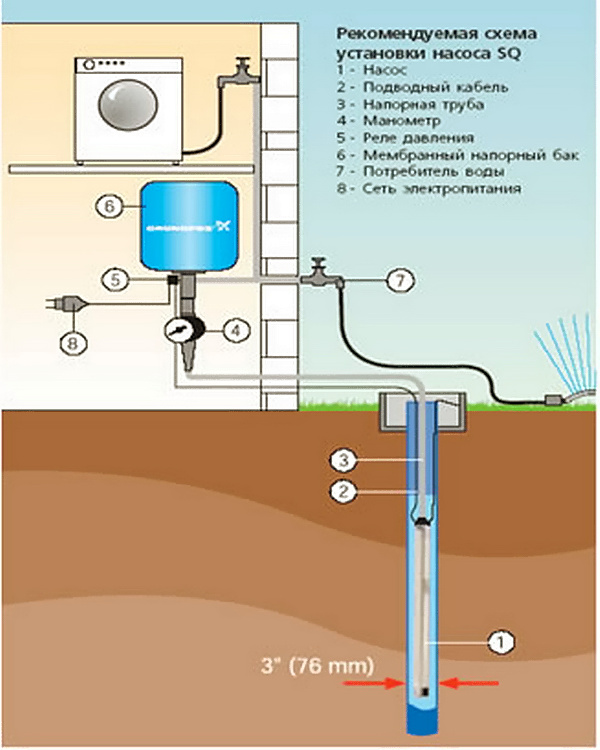
H is the minimum head, m;
P is the standard value and is equal to 2.5-3 atm;
. ∆H is the difference between the maximum draw-off point and the dynamic water level, m. If a suction pump is used, then the distance between the highest draw-off point and the pump equipment itself is taken as this value;
. ∑∆P - the value characterizing the hydraulic losses in the pipeline (approximately 10% of its length), filters, corners, tees (15-20%).
After carrying out the calculations, it is necessary to select the pump model, which, according to its characteristics, is closest to the previously calculated indicators. Next, you need to compare the diameters of the well and the pump. If a submersible pump is used, its diameter should be smaller. If the instructions provide for the installation of a downhole adapter, then you need to make sure that the pump passes where its static component is located.
Recommendations for calculating the pump power for water wells.
Sometimes people ask such questions: advise a good well pump because the old one no longer copes with its task.
The answers to the most common questions will be given below in the form of recommendations from experts.
1. When choosing a pump, try not to give preference to options with vibration, although their price is lower. This type of equipment is more suitable for ordinary wells, since their communications are covered with sand over time.
2. It is better to choose centrifugal type submersible pumps. This will avoid filling the well with sand.
3. To obtain better quality water, install the pump at least 1 m away from the filter.
4. When using water, it is necessary to take into account not only average values, but also peak values. Also make sure that there is enough water for technical purposes (watering the garden, washing the car, etc.).
5. To ensure good water pressure, it is necessary to choose a pump with a power margin of 20% of the selected value. This will create overpressure in the system and ensure excellent water pressure. Pressure reduction is facilitated by factors such as silting of water pipes, the use of filters. It will not work to make this type of calculation without the necessary knowledge and skills, so it is better to turn to professionals for help.
6. Try to lower the pump 1 m below the dynamic water level. By this measure, prevent the engine from being cooled by water that comes in from outside.
![]()
8. Please note that the diameter of the pump must be at least 1 cm smaller than the diameter of the well itself. This will extend the life of the pump and simplify the installation / dismantling of equipment. For example, if the well is 76 cm in diameter, then the pump must be selected according to a diameter of no more than 74 cm.
Conclusion on the calculation of pump power.
At calculation of pump power for organizing wells for the purpose of water supply, it is necessary to take into account many different nuances that affect its performance and operation. If you are not sure about own forces then entrust this matter to specialists.
Depending on the purpose of the well, it can be equipped with other types of pumps:
- Ordinary downhole units designed for placement in artesian wells. Able to supply clean drinking water from great depths.
- Well pumps. Such units can be equipped with any wide wells designed to take water for a variety of needs, including for providing water supply to the house, irrigation, etc.
- Drainage. Are intended for installation and use in sewer wells.
What else to look for when choosing equipment?
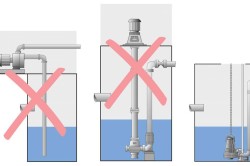
In order for the selected well pump to fully meet the requirements of the owner and perform all the tasks assigned to him with dignity, a number of additional criteria must be taken into account, namely:
You need to measure the depth of your well, and then, when studying the characteristics of the pump, compare the measured value with the maximum allowable immersion depth according to the passport. A large selection of submersible pump models with a wide variety of characteristics is available on sale, so you can easily select the right unit.
Dynamic water level in the well. The performance of the source on the site directly depends on this most important indicator. This characteristic indicates the maximum possible distance between the water surface and the ground during continuous operation of the equipment. It is important to determine the volume of water that the source will be able to produce for a certain time period. If after 30 minutes of work a sufficient amount of water still remains above the surface, then this is a very good indicator.
The static water level at the source indicates the distance between the bottom surface and the water. It can be easily determined on your own. To do this, you need not to use the well for several days, and then lower a load into it, tied to a sufficiently long and strong rope. On the rope, first make marks to calculate the height. You will hear a splash when the weight reaches the surface of the mirror. Record the elevation and then subtract the static level from the total depth. So you determine the value of the water column.
The diameter of the well in the area is also very important, since the pump must be selected taking into account the parameters of the well. Otherwise, you simply won't be able to use it effectively.
With such a moment as water consumption, you need to decide even before you start drilling a well. When calculating, you can use the previously given data or the average value, according to which one person consumes about 200 liters of water per day. Be sure to take into account the presence of children and pets, as well as the nature of living in the house, i.e. people will live in it permanently or they will come for a while. The calculation should take into account the presence of a greenhouse, vegetable garden, orchard and other plantings. As a rule, 2000 l / day is enough for all this. Equipment capable of delivering 40 liters of water per minute has similar characteristics.
Another important parameter is pressure. It can be calculated on your own. To do this, you need to calculate the depth of the well, increase the resulting value by 30, and then add another 10% of it to the result. For example, a well in the area has a depth of 45 m. The calculated water column for such a well will be 75 m. Add another 10% and you get a value equal to 83 m. For this example, you need to select equipment that can provide a head of 90 m.
When choosing such equipment, you need to pay special attention to its cost. At this stage, experts advise paying attention not only to the price of the pump itself, but also to the cost different kind additional equipment. Installation is carried out using an automatic machine for the operation of the pump, a stainless steel cable, and additional fittings. It is not recommended to buy suspiciously cheap equipment and components from little-known manufacturers. But buying too expensive units does not always make sense. The best option This is a mid-range equipment optimal values prices and quality.
Majority autonomous systems heating, which are used for heating country houses and cottages, today they are equipped with circulation pumps. In order to achieve the required results when installing such a hydraulic machine, it is necessary to perform a preliminary calculation circulation pump for the heating system and, based on the values obtained, select pumping equipment with the appropriate characteristics.
Spheres of use of circulation pumps
The main task of the circulation pump is to improve the circulation of the coolant through the elements of the heating system. The problem of already cooled water entering the heating radiators is well known to the residents of the upper floors. apartment buildings. Such situations are related to the fact that the coolant in such systems moves very slowly and has time to cool down until it reaches the areas heating circuit located at a considerable distance.
When operating in country houses autonomous heating systems, in which water circulates naturally, you can also encounter a problem when radiators installed at the farthest points of the circuit barely heat up. This is also a consequence of insufficient coolant pressure and its slow movement through the pipeline. To avoid such situations both in apartment buildings and in private houses, the installation of circulation pumping equipment allows. Forcibly creating the required pressure in the pipeline, such pumps provide a high speed of movement of heated water even to the most distant elements of the heating system.
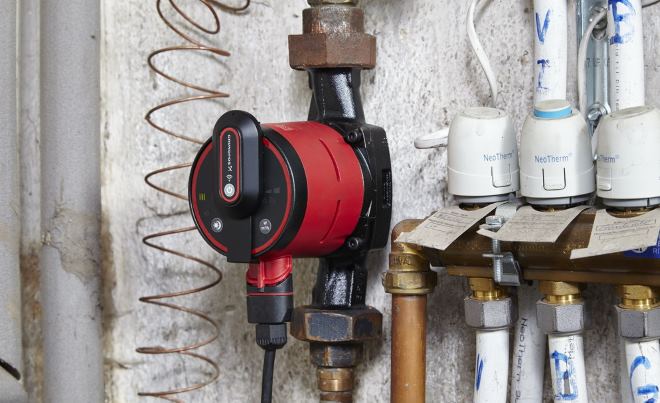
The efficiency of a heating system with natural circulation of a liquid carrying thermal energy, manifest when they are used to heat houses small area. However, if you equip such systems with a circulation pump, you can not only increase the efficiency of their use, but also save on heating by reducing the amount of energy consumed by the boiler.
According to its design, the circulation pump is a motor, the shaft of which transmits rotation to the rotor. A wheel with blades is installed on the rotor - an impeller. Rotating inside the working chamber of the pump, the impeller pushes the heated liquid entering it into the discharge line, forming a coolant flow with the required pressure. Modern models of circulation pumps can operate in several modes, creating different pressures of the coolant moving through them in heating systems. This option allows you to quickly warm up the house when cold weather sets in, by running the pump on maximum power, and then, when the whole building is formed comfortable temperature air, switch the device to economy mode.
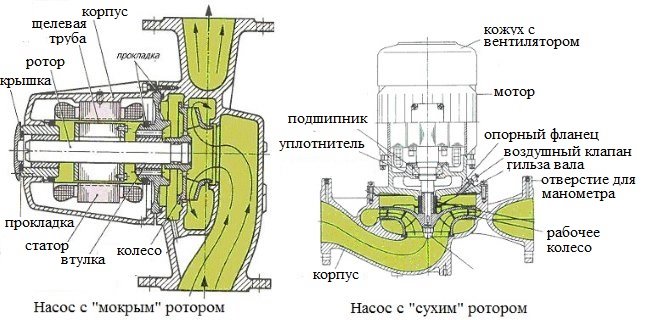
All circulation pumps used to equip heating systems are divided into two large categories: devices with a "wet" and "dry" rotor. In pumps of the first type, all elements of the rotor are constantly in the coolant medium, and in devices with a “dry” rotor, only a part of such elements is in contact with the pumped medium. Pumps with a “dry” rotor are distinguished by greater power and higher efficiency, but they make a lot of noise during operation, which cannot be said about devices with a “wet” rotor, which emit minimal amount noise.
Why do you need to calculate
The circulation pump installed in the heating system must effectively solve two main tasks:
- create in the pipeline such a liquid pressure that will be able to overcome the hydraulic resistance in the elements of the heating system;
- ensure the constant movement of the required amount of coolant through all elements of the heating system.
In order for the circulation pump to be able to cope with the solution of the above tasks, such a device should be selected only after the heating calculation has been made.
When performing such a calculation, two main parameters are taken into account:
- the total need of the building for thermal energy;
- the total hydraulic resistance of all elements of the heating system being created.
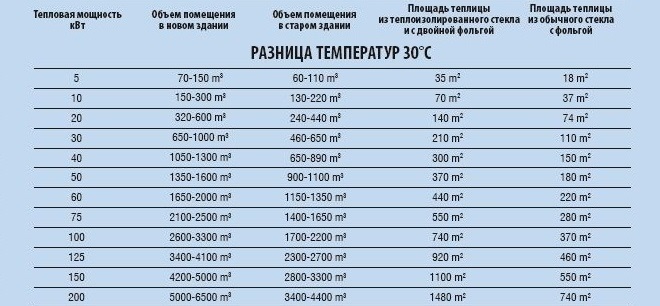
Table 1. Thermal power for various premises
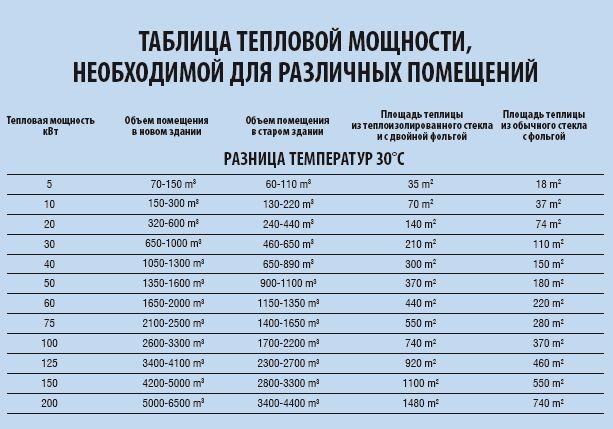
After determining these parameters, it is already possible to perform the calculation centrifugal pump and, based on the obtained values, select a circulation pump with the appropriate technical specifications. The pump selected in this way will not only provide the required pressure of the coolant and its constant circulation, but also work without excessive loads, which can cause the device to quickly fail.
How to calculate pump performance correctly
Such an important parameter of the circulation pump as its performance indicates how much coolant it can move per unit of time. The calculation of the performance of the circulation pump, which is denoted by the letter Q, is performed according to the following formula:
Q = 0.86R/TF-TR.
The parameters used in this formula are listed in the table.
Tables from text

The need for the premises of the house in the amount of heat for their heating, which is denoted by the letter R, is determined depending on the climatic conditions of the area in which such a house is located. So, for houses that are operated in a European climate, choose the following values given parameter:
- private houses of small and medium area - 100 kW per 1 m 2;
- apartment buildings- 70 kW per 1 m 2 of the area of \u200b\u200btheir premises.
In the event that the calculation of the performance of the pump for heating is performed for buildings with low thermal insulation characteristics, the value of thermal power, substituted into the formula, should be increased. For industrial premises, as well as premises located in buildings with good thermal insulation, the value of the parameter R is taken equal to 30–50 kW / m 2.
How to calculate the hydraulic losses of a heating system
The choice of a circulation pump in terms of its power and the pressure it creates, as mentioned above, is also influenced by such an important parameter of the heating system as hydraulic resistance, which is created by all elements of its equipment. Knowing the hydraulic resistance created separate elements heating system, you can calculate the suction height of the pump and, guided by this parameter, select the equipment model for power and generated pressure. To calculate the suction lift of the pump, which is denoted by the letter H, the following formula is needed:
H = 1.3x(R1L1+R2L2+Z1……..Zn)/10000.
The parameters used in this formula are listed in the table.
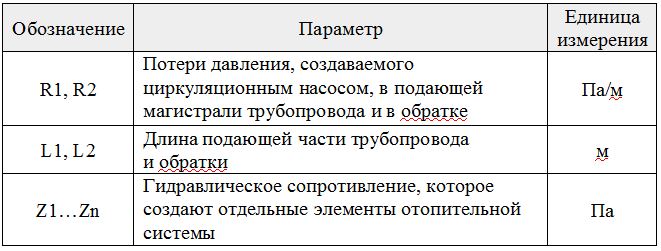
The values of R1 and R2 used in this formula should be selected according to a special information table.
Values of hydraulic resistance created various devices, which are used to equip heating systems, are usually indicated in the technical documentation for them. If there is no such data in the passport for the device, then you can use the approximate values of hydraulic resistance:
- heating boiler - 1000–2000 Pa;
- sanitary faucet - 2000–4000 Pa;
- thermal valve - 5000–10000 Pa;
- a device for determining the amount of heat - 1000–1500 Pa.
There are special information tables that can be used to determine the hydraulic resistance for almost any element of heating systems equipment.
Knowing the suction height, for the calculation of which the above formula is used, it is possible to optimally select pumping equipment according to its power, and also determine what the pump head should be.
How to choose a circulation pump by the number of speeds
Usually modern models circulation pumps are equipped with a regulating mechanism that allows you to change the speed of their work. Using such a mechanism, which, as a rule, has three stages of adjustment, it is possible to adjust the pump according to the flow rate of the liquid supplied to the heating system. So, with a sharp cold snap on the street and, accordingly, in the house, the pump can be turned on at maximum speed, and when it gets warmer, choose a different mode.
The control element, with which the speed of the circulation pump is changed, is the lever on the body of the device. Some models of circulation pumps are equipped with a system for auto-regulating the speed of their operation, which varies depending on temperature regime in room.
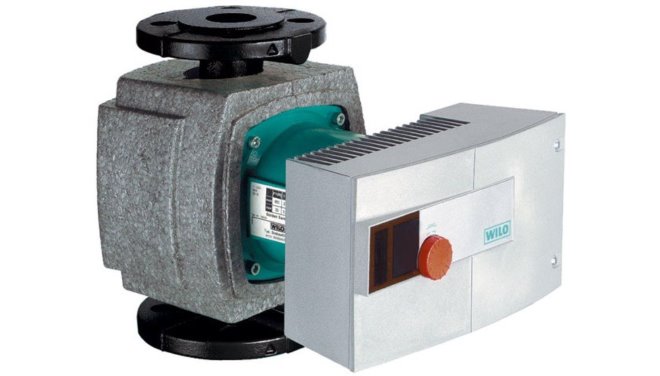
The above methodology is just one example of the calculations that are necessary in order to select a circulation pump for a warm floor or heating system. Specialists involved in heating systems use various methods for calculating the pump head (as well as the performance and other parameters of such devices), which make it possible to select such equipment according to its power and the pressure generated. In many cases, the owner of the house in which it is necessary to mount heating system, you don’t even have to ask questions about how to calculate the power of the pump and how to choose pumping equipment. Many manufacturers provide the services of qualified specialists or offer online services for calculating the parameters of the circulation pump and choosing it for heating systems or underfloor heating.








